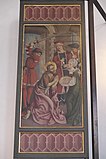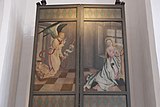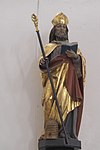St. Laurentius (Neustadt an der Donau)
The Roman Catholic parish church of St. Laurentius in Neustadt an der Donau , a small town in the Lower Bavarian district of Kelheim , is a late Gothic hall church that was partially destroyed in the Second World War and then rebuilt in Gothic style.
history
The first church in Neustadt was probably built in the 13th century, shortly after the city was founded in 1270. At that time Neustadt was still a branch of the original parish of Gögging , to which Abensberg and Biburg once belonged. At the end of the 15th century, the late Gothic hall church, which has largely been preserved, was built at the central street crossing in the city.
During the Baroque era , the furnishings were adapted to the tastes of the time. In 1640 the church received a richly decorated monstrance with Ingolstadt's hallmarks and new bells in 1673 and 1683. In 1723 the tower was given a new upper floor and in 1773 a baroque dome. From 1741 the interior was redesigned, the work was completed in 1779 with the purchase of a new high altar. On the altar sheet painted by Christian Fröhlich the martyrdom of the church patron Laurentius of Rome was depicted, a copy of a work by Joachim von Sandrart .
In 1802, the cemetery was moved from the area around the parish church to the St. Nicholas Chapel in the south of the city. Between 1854 and 1867, the interior of the church was given a neo-Gothic decoration while retaining the baroque high altar. Around 1900 and in 1929 interior renovations were carried out, with the latter one discovered old wall and ceiling paintings, which could not be restored and conserved due to limited financial means. In 1902 the parish church received a new organ. The church tower was badly damaged by artillery bombardment on April 26th and 27th, 1945, i.e. before the end of World War II, so that it collapsed in October 1945 due to dilapidation and destroyed the choir, including the baroque high altar.
The reconstruction was initially delayed for financial reasons, until in 1948 ashlars were obtained free of charge from the Marching quarry. During the work under the Regensburg government building director Franz Günthner, the nave was lengthened by a yoke in the destroyed eastern area , so the choir moved further to the east. The interior of the church was equipped with a star rib vault in a formal alignment with the still existing late Gothic yokes . The choir tower was rebuilt in modern forms. In 1951 the rebuilt church building was consecrated by Archbishop Michael Buchberger . In 1956, the parish church received a cycle of the Stations of the Cross by the artist Robert Rabolt, with the first eleven stations being executed as glass paintings in the lower area of the aisle windows.
In 1997 the parish church's last exterior renovation took place. Because of the flooding of large parts of the city during the Whitsun flood in 1999 , the work had to be interrupted. In 2007 the interior was renovated and redesigned according to plans by Franz Bernhard Weißhaar . The parish church received a new popular altar , ambo and tabernacle . The altar was consecrated on October 21, 2007 by Bishop Gerhard Ludwig Müller . In the following year the parish received a new organ from the Upper Austrian company Kögler .
In 1653 the parish seat was moved from Gögging to Neustadt, and Gögging thus became a branch of Neustadt. In 1700 Gögging was again raised to the position of Expositur , but it was not until 1989 that the place , which had meanwhile been declared a spa , received its own parish seat again.
description
architecture
The late Gothic hall church today is a plastered brick building with a continuous saddle roof over the nave and choir. The five-storey choir tower made of Marching limestone rises almost 61 meters above the east choir . The square substructure has three high sound openings on each side; above is the clock floor, which ends on each side with a triangular gable and thus leads to the upper end, an octagonal turret with a pyramid roof . A two-storey sacristy is attached to the north side of the choir . The church building has typically Gothic pointed arch windows , which are divided by two continuous vertical ribs. Access to the church is either via the two preserved late Gothic pointed arch portals in the eighth rearmost yoke of the side aisles or via the newly created entrances with a vestibule in the second north yoke and in the fourth south yoke.
Seven round pillars on each side divide the interior of the church into three equally high naves with reddish-colored star rib vaults. The pointed arches grow out of the pillars without mediation. In the vault you can see some coats of arms, probably from the nobility and middle classes. The keystones have been carrying Christian symbols since the reconstruction in the 20th century - in the central nave the works of mercy , in the south aisle Christ signs with the themes of Passion and Resurrection and in the north aisle the seven sacraments and symbols from the Lauretanian litany . For the new organ, which was built in 2008, the west gallery that was drawn in during the reconstruction in the 20th century was removed; the stately instrument takes up almost the entire width and height of the central nave. The gallery parts in the two side aisles were left in place, with the communion benches being used as parapets from the reconstruction.
Furnishing
The interior of the church is very simply furnished according to the specifications of the Second Vatican Council . In the chancel, in addition to the people's altar, ambo and tabernacle, the stained glass in the rear window by Robert Rabolt from 1957 is particularly noteworthy. It shows a representation of the Trinity , a so-called mercy seat , flanked by a Mater Dolorosa and the martyrdom of the church patron Laurentius.
The north side altar, a valuable work from around 1500, is a winged tare that, when closed, conceals a late Gothic figure of Mary of unknown origin. On the outside of the wings there is a painting of the Annunciation to Mary , on the inside the decapitation of John the Baptist and the apostle John with the poison cup are depicted.
The southern side altar consists only of figures from the neo-Gothic high altar. The main character is St. Wolfgang , accompanied by the four church fathers, Ambrosius , Hieronymus , Augustine and Gregory the Great , on processional poles . Also of interest is the figure of St. Lawrence, who was originally the main figure of the neo-Gothic high altar and is now placed on one of the northern pillars.
There are also numerous historical grave monuments in the church, including a red marble epitaph from Baron Ludwig von Stinglheim zu Karpfenstein († 1593).
organ
The new organ , inaugurated on December 14, 2008, was built by Orgelbau Kögler from St. Florian in Upper Austria . It is a purely mechanical slider chest instrument with a total of 31 registers on two manuals and a pedal . The disposition is as follows:
|
|
|
||||||||||||||||||||||||||||||||||||||||||||||||||||||||||||||||||||||||||||||||||||||||||||||||||||||||||||||||||||||||||||||||||||||||||||
- Coupling : I / II, I / P, II / P
- Playing aids : Tremulant, Zimbelstern
Peal
In the tower of the parish church there are four bells, which give an incomplete minor ring . The originally largest bell with the strike note b 0 , which has not been replaced after the Second World War, is missing . The bells in detail are:
- missing bell: b 0
- present until the Second World War, 2,800 kg
- Bell 1: c sharp 1
- Johann Hahn , Landshut 1950, 1,750 kg
- Bell 2: e 1
- Caspar Haslaver, Ingolstadt 1673, 1,250 kg
- Bell 3: f sharp 1
- Johann Gordian Schelchshorn , Regensburg 1683, 850 kg
- Bell 4: g sharp 1
- Johann Hahn, Landshut 1950, 650 kg
literature
- Heide Weißhaar-Kiem: City parish church St. Laurentius - Neustadt an der Donau . Schnell & Steiner, Regensburg 2011. 1st edition. ISBN 978-3-7954-6924-5 . Online version
Web links
Individual evidence
- ↑ Chronicle of the parish up to the 16th century . Online at pfarrei-neustadt-donau.de. Retrieved April 10, 2016.
- ↑ a b c d Chronicle of the parish from 1609 to 1984 . Online at pfarrei-neustadt-donau.de. Retrieved April 10, 2016.
- ↑ a b Chronicle of the parish from 1985 . Online at pfarrei-neustadt-donau.de. Retrieved April 10, 2016.
- ^ A b c d Heide Weißhaar-Kiem: City parish church St. Laurentius - Neustadt an der Donau . Schnell & Steiner, Regensburg 2011. 1st edition. ISBN 978-3-7954-6924-5 .
- ↑ The history of the organ . Online at pfarrei-neustadt-donau.de. Retrieved April 10, 2016.
- ↑ Disposition of the Kögler organ . Online at pfarrei-neustadt-donau.de. Retrieved April 10, 2016.
- ↑ Neustadt an der Donau - Disposition ( Memento of the original from April 10, 2016 in the Internet Archive ) Info: The archive link was inserted automatically and has not yet been checked. Please check the original and archive link according to the instructions and then remove this notice. . Online at www.orgelbau-koegler.at. Retrieved April 10, 2016.
- ^ New organs in the Diocese of Regensburg - Neustadt an der Donau . Online at www.kirchenmusik-regensburg.de. Retrieved October 15, 2016.
- ^ Bells of the Sankt Laurentiuskirche in Neustadt an der Donau . Online at www.youtube.com. Retrieved October 15, 2016.
Coordinates: 48 ° 48 ′ 33.1 " N , 11 ° 45 ′ 47.7" E











